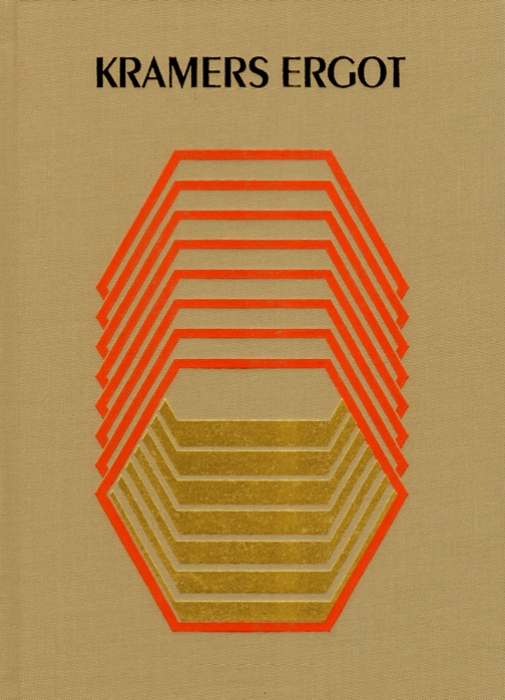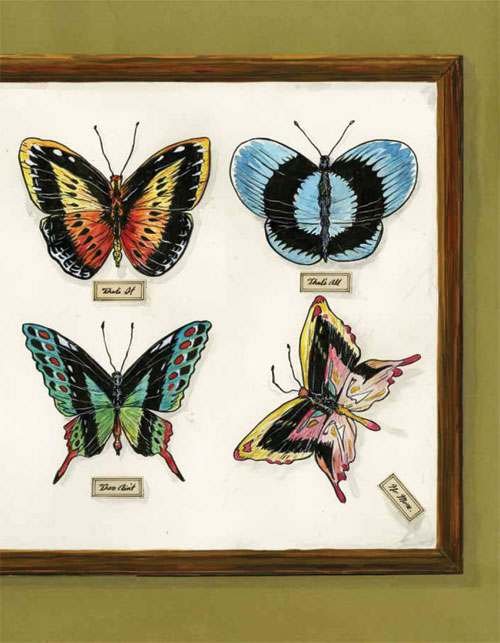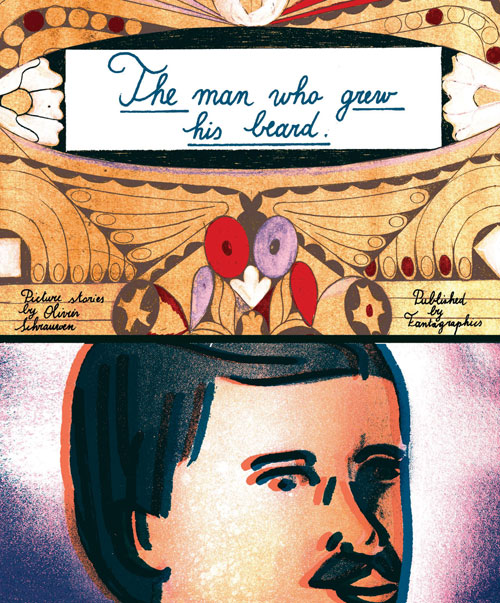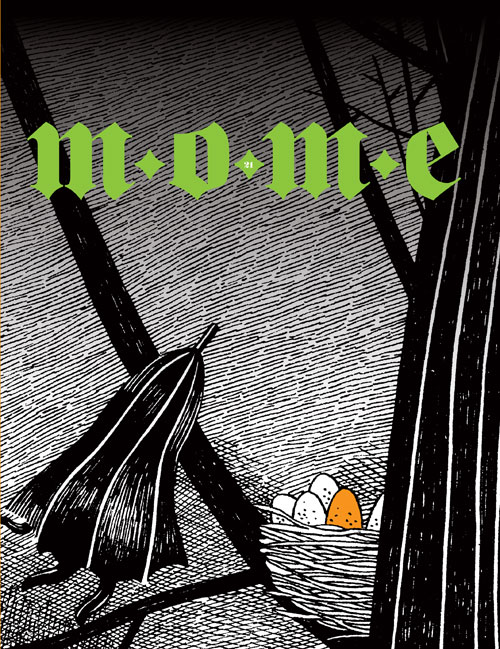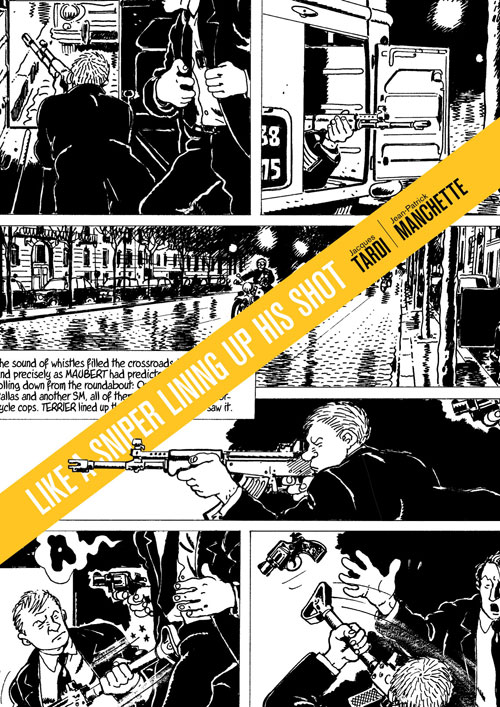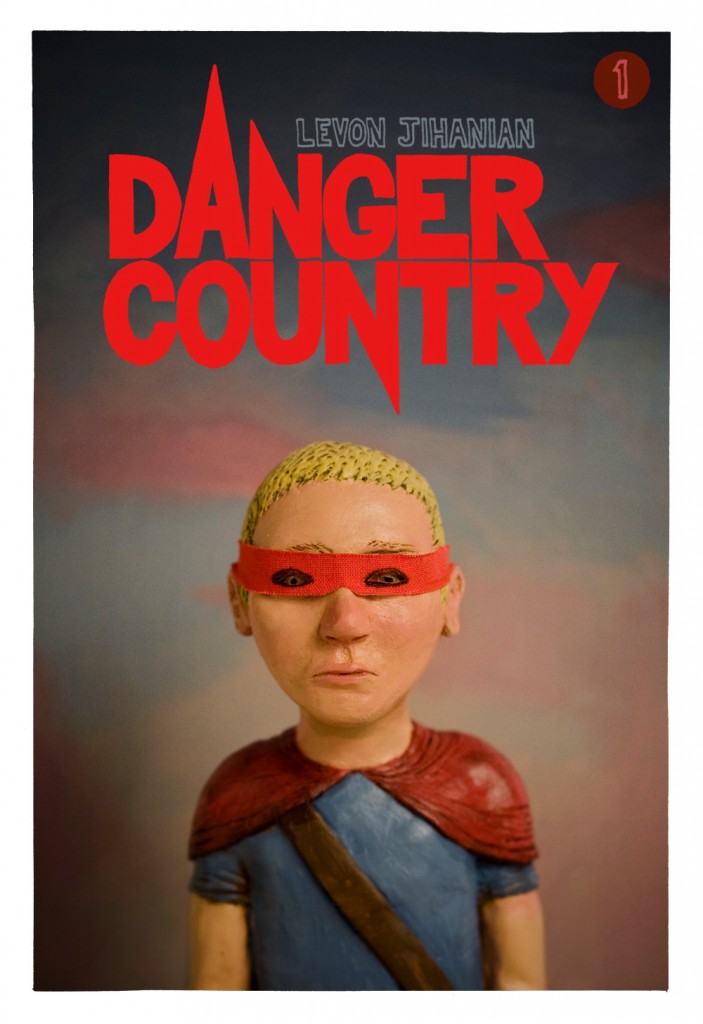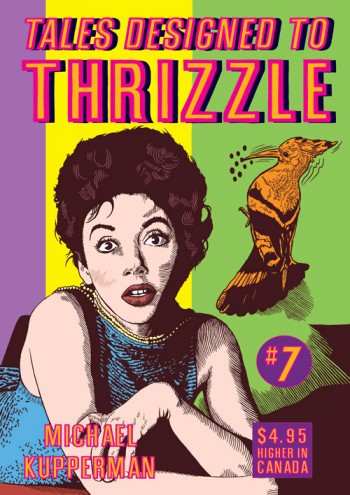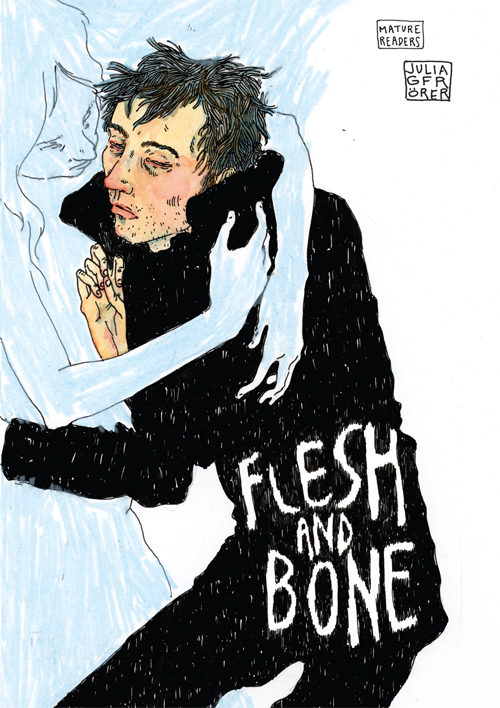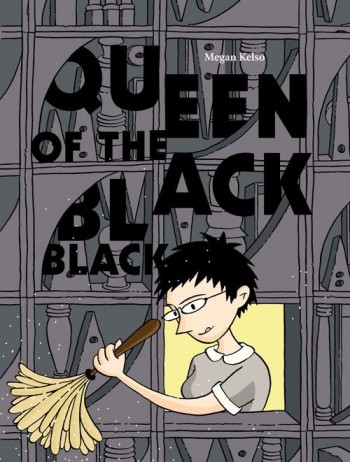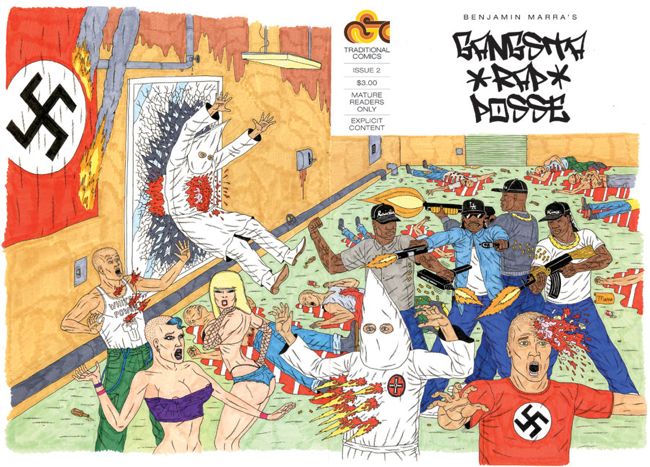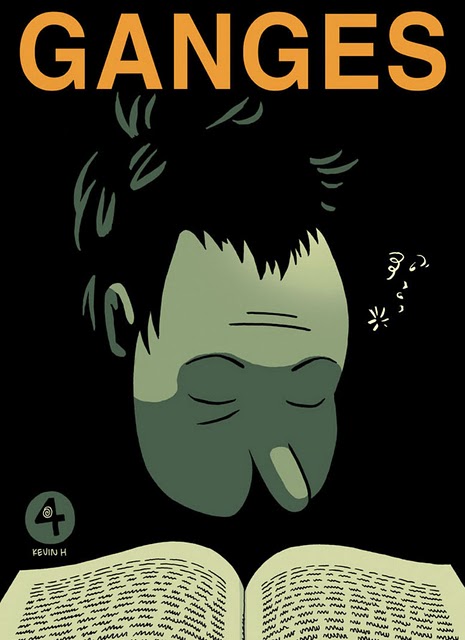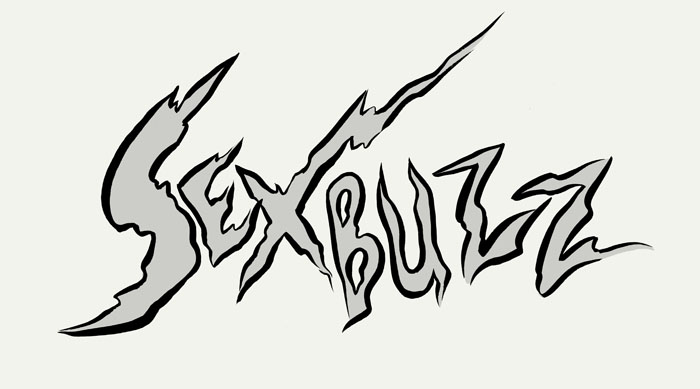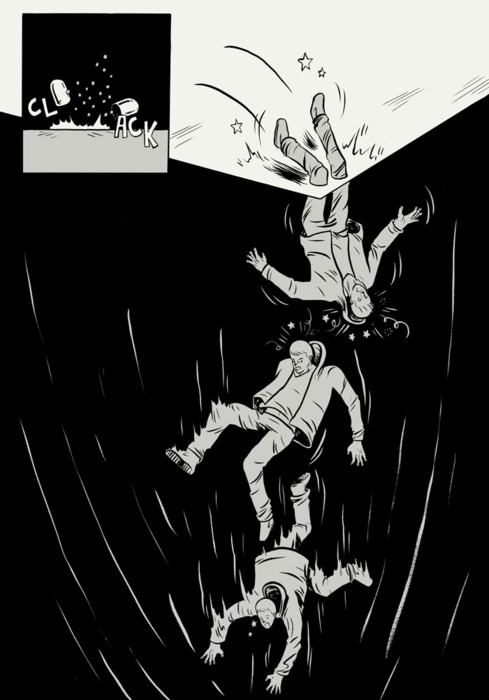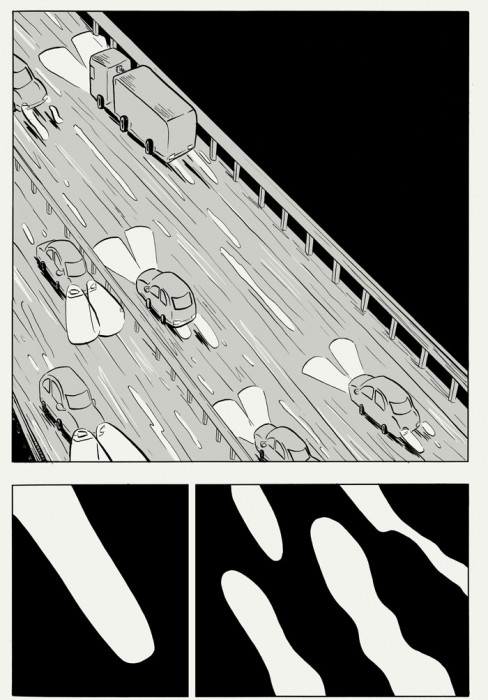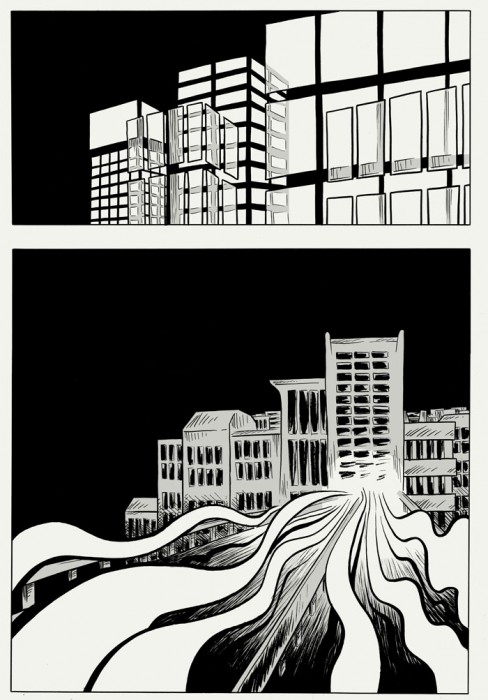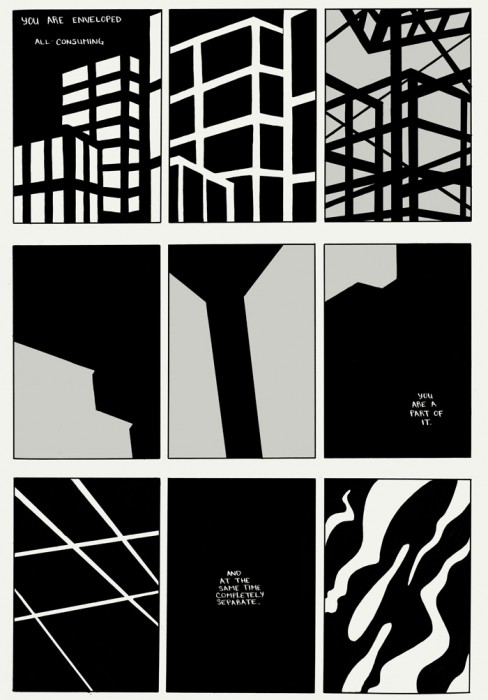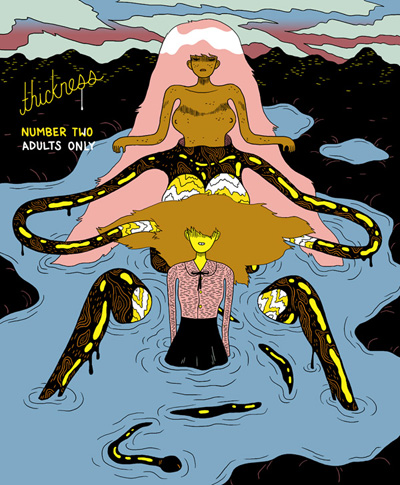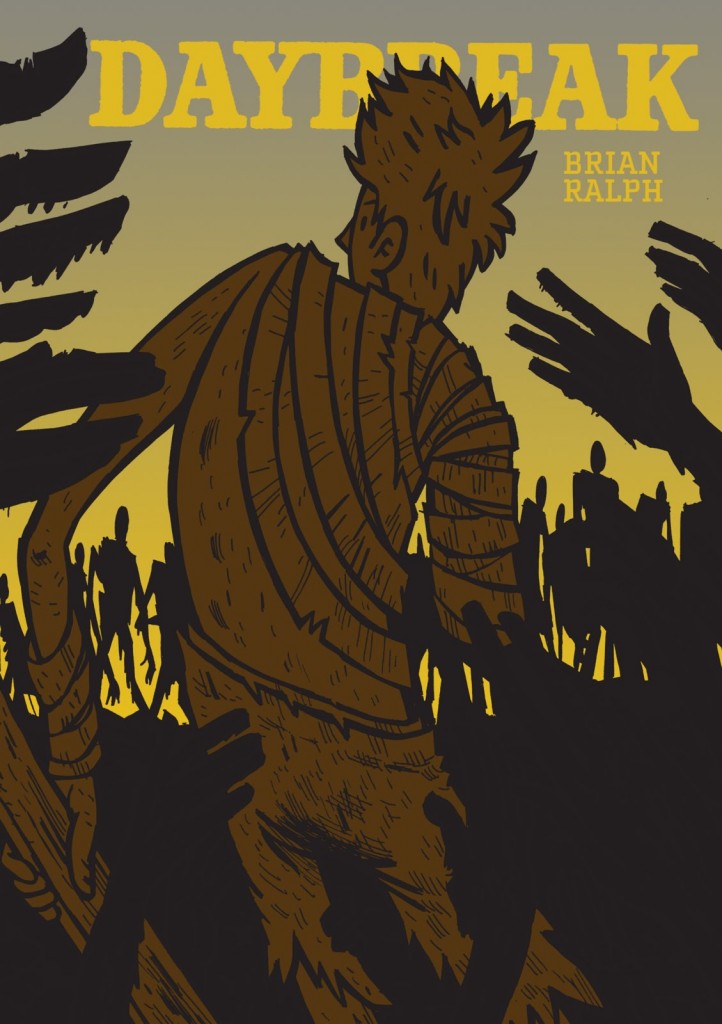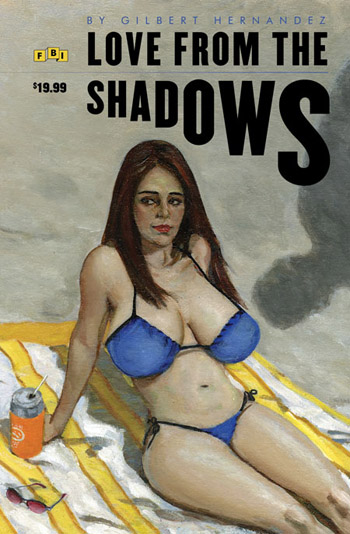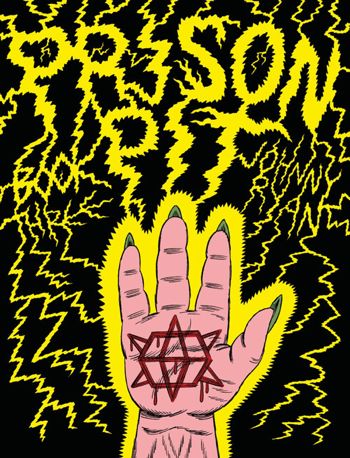Posts Tagged ‘comics reviews’
Comics Time: Kramers Ergot 8
January 18, 2012Kramers Ergot 8
Robert Beatty, Gabrielle Bell, Chris Cilla, Anya Davidson, Ron Embleton, C.F., Sammy Harkham, Tim Hensley, Kevin Huizenga, Ben Jones, Frederic Mullalley, Takeshi Murata, Gary Panter, Johnny Ryan, Leon Sadler, Frank Santoro, Dash Shaw, Ian Svenonius, writers/artists
Sammy Harkham, editor
PictureBox, January 2012
232 pages, hardcover
$32.95
Buy it from PictureBox
Buy it from Amazon.com
For today’s Comics Time review, please visit The Comics Journal.
The 20 Best Comics of 2011
January 1, 201220. Uncanny X-Force (Rick Remender and Jerome Opeña, Marvel): In a year when the ugliness of the superhero comics business became harder than ever to ignore, it’s fitting that the best superhero comic is about the ugliness of being a superhero. Remender uses the inherent excess of the X-men’s most extreme team to tell a tale of how solving problems through violence in fact solves nothing at all. (It has this in common with most of the best superhero comics of the past decade: Morrison/Quitely/etc. New X-Men, Bendis/Maleev Daredevil, Brubaker/Epting/etc. Captain America, Mignola/Arcudi/Fegredo/Davis Hellboy/BPRD, Kirkman/Walker/Ottley Invincible, Lewis/Leon The Winter Men…) Opeña’s Euro-cosmic art and Dean White’s twilit color palette (the great unifier for fill-in artists on the title) could handle Remender’s apocalyptic continuity mining easily, but it was in silent reflection on the weight of all this death that they were truly uncanny.
19. The League of Extraordinary Gentlemen Vol. 3: Century #2: 1969 (Alan Moore and Kevin O’Neill, Top Shelf/Knockabout): I’ll admit I’m somewhat surprised to be listing this here; I’ve always enjoyed this last surviving outpost of Moore’s comics career but never thought I loved it. But in this installment, Moore and O’Neill’s intrepid heroes — who’ve previously overcome Professor Moriarty, Fu Manchu, and the Martian war machine — finally succumb to their own excesses and jealousies in Swinging London, allowing a sneering occult villain to tear them apart with almost casual ease. It’s nasty, ugly, and sad, and it’s sticking with me like Moore’s best work.
18. The comics of Lisa Hanawalt (various publishers): As I put it when I saw her drawing of some kind of tree-dwelling primate wearing a multicolored hat made of three human skulls stacked on top of one another, Lisa Hanawalt has a strange imagination. And it’s a totally unpredictable one, which is what makes her comics – whether they’re reasonably straightforward movie lampoons or the extravagantly bizarre sex comic she contributed to Michael DeForge and Ryan Sands’s Thickness anthology, as dark and damp as the soil in which its earthworm ingénue must live – a highlight of any given day a new one pops up.
17. Daybreak (Brian Ralph, Drawn and Quarterly): Fort Thunder’s single most accessible offspring also proves to be its bleakest, thanks to an extended collected edition that converts a rollicking first-person zombie/post-apocalypse thriller into a troubling meditation on the power of the gaze. Future artcomics takes on this subgenre have a high bar to clear.
16. Habibi (Craig Thompson, Pantheon): It’s undermined by its central characters, who exist mainly as a hanger on which this violent, erotic, conflicted, curious, complex, endlessly inventive coat of many colors is hung. But as a pure riot of creative energy from an artist unafraid to wrestle with his demons even if the demons end up winning in the end, Habibi lives up to its ambitions as a personal epic. You could dive into its shifting sands and come up with something different every time.
15. Ganges #4 (Kevin Huizenga, Coconino/Fantagraphics): Huizenga wrings a second great book out of his everyman character’s insomnia. It’s quite simple how, really: He makes comics about things you’d never thought comics could be about, by doing things you never thought comics could do to show you them. Best of all, there’s still the sense that his best work is ahead of him, waiting like dawn in the distance.
14. The Congress of the Animals (Jim Woodring, Fantagraphics): The potential for change explored by the hapless Manhog in last year’s Weathercraft is actualized by the meandering mischief-maker Frank this time around. While I didn’t quite connect with Frank’s travails as deeply as I did with Manhog’s, the payoff still feels like a weight has been lifted from Woodring’s strange world, while the route he takes to get there is illustrated so beautifully it’s almost superhuman. It’s the happy ending he’s spent most of his career earning.
13. Mister Wonderful (Daniel Clowes, Pantheon): Speaking of happy endings an altcomix luminary has spent most of his career earning! Clowes’s contribution to the late, largely unlamented Funny Pages section of The New York Times Magazine is briefly expanded and thoroughly improved in this collected edition. Clowes reformats the broadsheet pages into landscape strips, eases off the punchlines and cliffhangers, blows individual images up to heretofore unseen scales, and walks us through a self-sabotaging doofus’s shitty night into a brighter tomorrow.
12. The comics of Gabrielle Bell (various publishers): Bell is mastering the autobiography genre; her deadpan character designs and body language make everything she says so easy to buy – not that that would be a challenge with comics as insightful as her journey into nerd culture’s beating heart, San Diego Diary, just by way of a for instance. But she’s also reinventing the autobiography genre, by sliding seamlessly into fictionalized distortions of it; her black-strewn images give a somber, thoughtful weight to any flight of fancy she throws at us. What a performance, all year long.
11. The Armed Garden and Other Stories (David B., Fantagraphics): Religious fundamentalism is a dreary, oppressive constant in its ability to bend sexuality to mania and hammer lives into weapons devoted to killing. But it has worn a thousand faces in a millennia-long carnevale procession of war and weirdness, and David B. paints portraits of three of its masks with bloody brilliance. Focusing on long-forgotten heresies and treating the most outlandish legends about them as fact, B.’s high-contrast linework sets them all alight with their own incandescent madness.
10. Too Dark to See (Julia Gfrörer, Thuban Press): It was a dark year for comics, at least for the comics that moved me the most. And no one harnessed that darkness to relatable, emotional effect better than Julia Gfrörer. Her very contemporary take on the legend of the succubus was frank and explicit in its treatment of sexuality, rigorously well-observed in its cataloguing of the spirit-sapping modern-day indignities that can feed depression and destroy relationships, and delicately, almost tenderly drawn. It’s like she held her finger to the air, sensed all the things that can make life rotten, and cast them onto the pages. She made something quite beautiful out of all that ugly.
9. The comics and pixel art of Uno Moralez (self-published on the web at unomoralez.com): What if an 8-bit NES cut-scene could kill? The digital artwork of Uno Moralez — some of it standard illustrations, some of it animated gifs, some of it full-fledged comics — shares its aesthetic with The Ring‘s videotape or Al Columbia’s Pim & Francie: a horror so cosmically black, images so unbearably wrong, that they appear to have leaked into and corrupted their very medium of transmission. Moralez fuses crosses the streams of supernatural trash from a variety of cultures — the legends and Soviet art of his native Russia, the horror and porn manga of Japan, the B-movies and horror stories of the States, the formless sensation aesthetic of the Internet itself — into a series of images that is impossible to predict in its weirdness but totally unflagging in its sense that you’d be better off if you’d never laid eyes on it. I can’t wait to see more.
8. The comics of Michael DeForge (various publishers): The last time you saw a cartoonist this good and this unique this young, you were probably reading the UT Austin student newspaper comics section and stumbling across a guy named Chris Ware. All four of DeForge’s best-ever comics — his divorced dad story in Lose #3, his shape-shifting/gender-bending erotica in Thickness #2, his self-published art-world fantasia Open Country, and his gorgeously colored body-horror webcomic Ant Comic — came out this year, none of them looking anything at all like anything you could picture before seeing your first Michael DeForge comic. It’s almost frightening to think where he’ll be five years from now, ten years from now…or even just this time next year.
7. The comics and art of Jonny Negron (various publishers): What if someone took Christina Hendricks’s walk across the parking lot and trip to the bathroom in Drive and made an entire comics career out of them? That is an enormously facile and reductive way to describe the disturbing, stylish, sexy, singular work of Jonny Negron, the breakout cartoonist of the year, but it at least points you in the right direction. No one’s ever thought to combine his muscular yet curiously dispassionate bullet-time approach to action and violence, his Yokoyama-esque spatial geometry, his attention to retrofuturistic fashion and style, his obvious love of the female body in all its shapes and sizes, and his ambient Lynchian terror; even if they had, it’d be tough to conceive of anyone building up his remarkable body of work in such a short period of time. Open up your Tumblr dashboard or crack an anthology (Thickness, Mould Map, Study Group, Smoke Signal, Negron and Jesse Balmer’s own Chameleon), and chances are good that Negron was the weirdest, best, most coldly beautiful thing in it. It’s like a raw, pure transmission from a fascinating brain.
6. The Wolf (Tom Neely, I Will Destroy You): Neely’s wordless, painted, at-times pornographic graphic novel feels like the successful final draft to various other prestigious projects’ false starts. It’s a far less didactic, more genuinely erotic attempt at high-art smut than Dave McKean’s Celluloid; a less self-conscious, more direct attempt at frankly depicting both the destructive and creative effects of sex on a relationship via symbolism than Craig Thompson’s Habibi; a blend of sex and horror and narrative and visual poetry and ugly shit and a happy ending that succeeds in each of these things where many comics choose to focus on only one or two.
5. The Cardboard Valise (Ben Katchor, Pantheon): Prep your time capsules, folks: You’d be hard pressed to find an artifact that better conveys our national predicament than Ben Katchor’s latest comic-strip collection, a series of intertwined vignettes created largely before the Great Recession and our political class’s utter failure to adequately address it, but which nonetheless appears to anticipate it. Its message — that blind nationalism is the prestige of the magic trick used by hucksters to financially and culturally ruin societies for their own profit — is delightfully easy to miss amid Katchor’s remarkable depictions of lost fads, trends, jobs, tourist attractions, and other detritus of the dying American Century. He’s the very most funnest Cassandra around.
4. Love from the Shadows (Gilbert Hernandez, Fantagraphics): I picture Gilbert Hernandez approaching his drawing board these days like Lawrence of Arabia approaching a Turkish convoy: “NO PRISONERS! NO PRISONERS!” In a year suffused with comics funneling pitch-black darkness through a combination of sex and horror, none were blacker, sexier, or more horrific than this gender-bending exploitation flick from Beto’s “Fritz-verse.” None also functioned as a rejection of the work that made its creator famous like this one did, either. Not a crowd-pleaser like his brother, but every bit as brilliant, every bit as fearless.
3. Garden (Yuichi Yokoyama, PictureBox): Like a theme park ride in comics form — with the strange events it chronicles themselves resembling a theme park ride — Yokoyama’s book is a breathtaking, breathless experience. Alongside his anonymous but extravagantly costumed non-characters, we simply go along for the ride, exploring Yokoyama’s prodigious, mysterious imagination as he concocts a seemingly endless stream of increasingly strange interfaces between man and machine, nature and artifice. As a metaphor for our increasingly out-of-control modern life it’s tough to top. As pure thrilling kinetic cartooning it’s equally tough to top.
2. Big Questions (Anders Nilsen, Drawn & Quarterly): Last year, I wrote that if the collected edition of Nilsen’s long-running parable of philosophically minded birds and the plane crash that turns their lives upside-down didn’t top my list whenever it came out, it must have been some kind of miracle year. Turns out that it was. But you’d pretty much have to create a flawless capstone to a thirty-year storyline of neer-peerless intelligence and artistry to top this colossal achievement. Nilsen’s painstaking, pointillist cartooning and ruthless examination of just how little regard the workings of the world have for any given life, human or otherwise, marks him as the best comics artist of his generation, and solidifies Big Questions‘ claim as the finest “funny animal” comic since Maus.
1. Love and Rockets: New Stories #4 (Gilbert and Jaime Hernandez, Fantagraphics): Gilbert got his due elsewhere on my list, so let’s ignore his contribution to this issue, which advance the saga of his bosomy, frequently abused protagonist Fritz Martinez both on and off the sleazy silver screen. Instead, let’s add to the chorus praising Jaime’s “The Love Bunglers” as one of the greatest comics of all time, the point toward which one of the greatest comics series of all time has been hurtling for thirty years. In a single two-page spread Jaime nearly crushes both his lovable, walking-disaster main characters Maggie and Ray with the accumulated weight of all their decades of life, before emerging from beneath it like Spider-Man pushing up from out of that Ditko machinery. You can count the number of cartoonists able to wed style to substance, form to function, this seamlessly on one hand with fingers to spare. A masterpiece.
Comics Time: Mome Vol. 22: Fall 2011
December 20, 2011Mome Vol. 22: Fall 2011
Zak Sally, Kurt Wolfgang, Jordan Crane, Chuck Forsman, Steven Weissman, Sara Edward-Corbett, Laura Park, Tom Kaczynski, Joe Kimball, Jesse Moynihan, Josh Simmons, The Partridge in the Pear Tree, Malachi Ward, Eleanor Davis, James Romberger, Derek Van Gieson, Michael Jada, Tim Lane, Nate Neal, Wendy Chin, Anders Nilsen, Tim Hensley, Lilli Carré, T. Edward Bak, Nick Drnaso, Joseph Lambert, Paul Hornschemeier, Sergio Ponchione, Nick Thorburn, Dash Shaw, Ted Stearn, Jim Rugg, Victor Kerlow, Noah Van Sciver, Gabrielle Bell, writers/artists
Eric Reynolds, editor
Fantagraphics, 2011
240 pages
$19.99
Buy it from Fantagraphics
Buy it from Amazon.com
For today’s Comics Time review, please visit The Comics Journal.
Comics Time: The Man Who Grew His Beard
December 19, 2011The Man Who Grew His Beard
Olivier Schrauwen, writer/artist
Fantagraphics, 2011
112 pages
$19.99
Buy it from Fantagraphics
Buy it from Amazon.com
I love the disconnect between how big and broad this substantial softcover feels in your hands — at 8.5″ x 10.25 ” it’s just wider enough than your average graphic novel for you to notice it — and how tiny the little mustachioed men who people most of its stories feel on those big pages, even when they’re blown up big enough to occupy most of that real estate. It makes it feel even more alien than it already does, like you’re reading a giant’s minicomic.
I don’t know how he does it, whether it’s something to do with how he puts his lines down on paper or some treatment he gives them afterwards, but Flemish cartoonist Olivier Schrauwen makes images that look like…like they’ve been transmitted from a great distance, both temporally and spatially. He’s playing with style and design that looks like it predates the Great War, and his line and coloring has a hazy feel to it that could be a copy of a copy of a copy, or the unlikely discovery of some microscopic cartooning culture blown up to many times its original size. There’s something off about it just as surely as there’s something off about Al Columbia’s rotted vintage visuals, only here that off-ness is used in service of a comic surrealism rather than a horrific one. He can stick it to the foibles of the 19th-century culture whose style he’s swiping quite effectively — savagely satirizing Belgium’s bloody misadventures in Africa, parodying the West’s penchant for physiognometric pseudoscience with a look at what your hairstyle says about your mental capacity, lampooning the world-conquering bravado of transcontinental rail, and so on. But he’s just as likely to seize upon some strange effect or idea and run with it as hard and as fast as he can — nearly literally, in once case, in a strip consisting more or less solely of a guy running to catch a train for as long and as far as the train would have taken him to begin with. Elsewhere, he shatters sexual idylls into a fractal feedback loop or draws its participants as lounging subjects of some kind of weird cubist stained-glass art style; portrays a man who can paint things into existence by trotting him through a series of guffaw-inducing mock-heroic poses, as if his miraculous creative abilities were only secondary proof of his awesomeness compared to his theatrical, bare-chested machismo; and uses bright color and titanically ornate architecture against bland ones to paint a portrait of a catatonic man’s rich and adventurous interior life of fun with a beautiful woman and a beloved child, in a story that ended up being actually quite moving. These are deeply strange short stories, centered on ideas and effects I’m not sure I’d have come up with even with the proverbial infinite number of monkeys at my disposal; even in this short-story-saturated alternative comics climate, there’s nothing else like his gestalt of finely calibrated nonsense. It’s good to see that comics can do things you’d never think to ask of them in the first place.
Comics Time: Mome Vol. 21: Winter 2011
December 16, 2011Mome Vol. 21: Winter 2011
Sergio Ponchione, The Partridge in the Pear Tree, Josh Simmons, Dash Shaw, Steven Weissman, Kurt Wolfgang, Sara Edward-Corbett, Nicolas Mahler, Tom Kaczynski,
Josh Simmons, Jon Adams, Nate Neal, T. Edward Bak, Michael Jada, Derek Van Gieson, Nick Thorburn, Lilli Carré, writers/artists
Eric Reynolds, editor
Fantagraphics, 2011
112 pages
$14.99
Buy it from Fantagraphics
Buy it from Amazon.com
It was the best of Momes, it was the worst of Momes. Alright, that’s not quite accurate, and not quite fair, either. But this unwittingly penultimate issue of Fantagraphics’ long-running alternative-comics anthology — page for page the longest-running such enterprise in American history! — is a hit-or-miss affair in the mighty Mome manner. In the miss column you can place Sergio Ponchione’s bombastic, cartoony fantasy about an imaginary childhood friend brought to life; there’s really not much more to it than that description would indicate. Ditto Kurt Wolfgang’s next “Nothing Eve” chapter, which continues to work the “people still act pretty much the same even though the end of the world is coming” buttons it’s been mashing since issue #1. T. Edward Bak’s “Wild Man” remains awkwardly paced due to its split-up narrative captions; Nicolas Mahler’s autobio strip remains of limited interest to people not Nicolas Mahler; Lilli Carré’s contribution is nicely colored in reds and blues but otherwise insubstantial.
A few contributions are both hit and miss at once. Sara Edward-Corbett’s near-wordless reverie involving inanimate objects romping around the outside of a house comes across more inscrutable than mysterious, but at the same time her crosshatching and linework are an absolute marvel, and she’s playing with forms (and with form) in a fashion reminiscent of John Hankiewicz, if not as successful. Steven Weissman’s deadpan “Barack Hussein Obama” strips fall flat when they merely parody the rhythms of four-panel gag comics, but spring to surreal and oddly scathing life when he injects a healthy dose of the sinister supernatural into them. I’ve never quite cottoned to the way Jon Adams’s razor-thin line and labored-over character renderings sit against the large white expanses of his pages, and his writing feels overwrought to me, but he does give his blackly humorous tale of a hunting expedition gone bad a laugh-out-loud visual punchline. And Nate Neal’s caveman morality play makes much better use of his meaty cartooning than his lukewarm slice-of-lifers do, though the conceit of gibberish dialogue from the cavepeople conceals more than it illuminates.
So that leaves the hits, and they’re strong enough to make the book worth checking out. Dash Shaw continues his seemingly ongoing series of adaptations of “reality” programming, this time an excerpt from a making-of documentary about Jurassic Park; he has a really sharp and off-kilter eye for people observing and commenting on their own behavior for a camera, and his transition from talking heads to full documentary “footage” is a gleeful one. Nick Thorburn’s take on Benjamin Franklin, a first-person monologue in which Ben lets us in on a dirty little secret, is anachronistically absurd (“In Seventeen-Sumthin’-Er-Other, right before I invented electricity and just after I’d sired my illegitimate son, I received an e-mail from Lord Sandwich about comin’ to London to take part in this new secret society known as ‘The Hellfire Club.'”) and very funny, with a great undergroundy character design for Franklin himself. Derek Van Gieson’s murky World War II period piece continues to stun from page to page. Tom Kaczynski examines home ownership during terminal-stage capitalism as only he can, casting it as a catalyst for powerful erotic and apocalyptic impulses and proving himself once again to be one of the most stealthily sexy cartoonists working today. “Stealthy” isn’t a word I’d use for Josh Simmons, but he doesn’t need it: His weird psychedelic fantasia on racism “The White Rhinoceros” is as bold and bulldozing as the giant slugs who stampede across its pages, and the elliptically concluded short story “Mutant” ends with an image of an enraged creature in the form of a human female, her nude body shadowed but covered in glistening sweat, that may as well symbolize the workings of Simmons’s entire brain. You gotta take the rough to find the diamonds.
Comics Time: Like a Sniper Lining Up His Shot
December 15, 2011Like a Sniper Lining Up His Shot
Jacques Tardi, writer/artist
Adapted from the novel by Jean-Patrick Manchette
Fantagraphics, 2011
104 pages, hardcover
$18.99
Buy it from Fantagraphics
Buy it from Amazon.com
Fantagraphics keeps churning out lovely translated editions of the work of French comics master Jacques Tardi at a truly admirable clip. This is the fourth in what I would consider the “main” Tardi/Fanta line of slim hardcovers, distinguished by no-nonsense Adam Grano cover designs that juxtapose key sequences from Tardi’s ink-soaked black-and-white interior art with bold slashes of color and block-caps for title and credit information. If there’s a better mesh of form and function in comics right now this side of, well, Fanta’s similarly designed Love and Rockets digests, I’d sure love to see it. In much the same vein as Tardi’s previously released adaptation of a crime novel by author Jean-Patrick Manchette, West Coast Blues, Like a Sniper Lining Up His Shot is a grimly economical story of a man on the run from killers, with bursts of violence that slash in out of nowhere. In other words, you can judge a book by its cover.
The two books have much in common beyond their common language of men hunted by hitmen across the length and breadth of France. Both protagonists are bizarrely taciturn about their predicaments, almost to the point where you’re left to wonder if there’s some sort of mental disability involved. Sniper‘s Martin Terrier (great name) at least has the excuse of being a mercenary and assassin to explain his flat affect where killing’s concerned, as opposed to West Coast Blues‘ wrong-man family-guy George. But he more than makes up for this in his personal life, a disaster area predicated entirely on his deeply weird belief that the women with whom he involves himself can switch their affections for him on and off after years of one setting or the other based solely on his say-so. The woman for whom he “risks it all” — Tardi and Manchette’s interpretation of this trope ladles those sneer quotes all over it — is an equally weird and unpleasant character, ricocheting from emotion to emotion when Terrier’s intrusion into the life she’d been leading without him violently upends her status quo, until finally settling on some weird sneering sex-hungry brand of derision for him and his life of crime and adventure.
In all honesty, these emotional and behavioral patterns are so difficult to recognize even when allowing for the remove between a hired gun and a comics critic that they get in the way of Tardi and Manchette’s underlying indictment of society’s casual savagery, and its propensity for covering up that savagery with bullshit that pins it on The Other Side. But upon reflection, I wonder if these terrible people’s wholly alien way of interacting with the world isn’t just the writing equivalent of Tardi’s nimble, scribbled line and sooty blacks — a heightened reality in which things are rendered at their loosest, darkest, ugliest, and weirdest at all times. God knows both creators can rigorously focus when they want: Manchette squeezes a quite believable custody battle between Terrier and his now-ex girlfriend over a beloved cat into the proceedings, while Tardi’s backgrounds and lighting effects are a realist’s dream and his action sequences and set-pieces are choreographed tighter than a drum. The absurdist demeanors may prevent everything from gelling as well as they might have done, but overall the book delivers a fastball to your face so hard that you barely have time to notice that some of the stitches need straightening.
Comics Time: The End of the Fucking World Part One
December 9, 2011The End of the Fucking World Part One
Chuck Forsman, writer/artist
self-published, December 2011
12 pages
$1
Buy it from Oily Boutique
How’s that for a title? And I’m pleased to say the contents are just as good. Forsman has become a must-read talent for me; each new minicomic shows growth. He’s a cartoonist of great restraint, in terms of both visuals (this is all slight, feathery lines and quiet, flat-affect “acting” from the characters) and pacing (this is all no-nonsense page-long vignettes, with dialogue and captions strategically deployed for a steady beat-beat-beat rhythm). His characters themselves feel considered and lived-in. The lead character here is a believably blasé creep recounting his childhood, marked by killing animals, mutilating himself, and discovering his inability to feel love or have a sense of humor. But thanks to a terrific hesher character design, his evident sociopathy come across not like some heavy-handed depiction of a budding Ted Bundy but like a satire of run-of-the-mill teenage-dirtbag-ism. He’s like Beavis Bateman.
These two potentially opposing views of our hero come together in the story’s centerpiece, the four pages dedicated to his going-through-the-motions relationship as a 16-year-old with his pretty, forward girlfriend Alyssa. It’s easy to see how his aloofness could come across as attractive, and the resulting, detailed depiction of skewed adolescent sexuality is as skeevy and funny and sexy and creepy as they come. He fantasizes about strangling her as she tells him “God, I want you” takes off her shirt; their tongues intertwine like snakes on a caduceus; he presses his face to the convex arc of her stomach as she presses his head down toward her underwear; they have the following amazing exchange as they snuggle on the couch watching TV:
“Have you ever eaten a pussy before?”
“Sure.”
“I want you to eat mine.”
“Right now?”
The awkwardness, the urgency, the sense of discovery, the sense of revulsion — it’s all true, even if you’ve never stuck your own hand in a garbage disposal on purpose or crushed a stray cat with a stone. Where those aspects of the story will take us is something I’m greatly looking forward to seeing in future issues, given where we’ve gone here.
Comics Time: Danger Country #1
December 8, 2011Danger Country #1
Levon Jihanian, writer/artist
Teenage Dinosaur, 2011
40 pages
$5
Buy it from Levon Jihanian
For today’s Comics Time review, please visit The Comics Journal.
Comics Time: 1-800-MICE
December 2, 20111-800-MICE
Matthew Thurber, writer/artist
PictureBox, 2011
176 pages, hardcover
$22.95
Buy it from PictureBox
Buy it from Amazon.com
For today’s Comics Time review, please visit The Comics Journal.
Comics Time: Tales Designed to Thrizzle #7
November 23, 2011Tales Designed to Thrizzle
Michael Kupperman, writer/artist
Fantagraphics, November 2011
32 pages
$4.95
Buy it from Fantagraphics
For today’s Comics Time review, please visit The Comics Journal.
Comics Time: Flesh and Bone
November 17, 2011Flesh and Bone
Julia Gfrörer, writer/artist
Sparkplug, 2010
40 pages
$6
Buy it from Sparkplug
Death as an irreparable rupture. Explicit, raw, wounded-animal sexuality. The calculating and casual torture and murder of children. Occult evil that actively belittles the human capacity for love and kindness. It’s tough to think of a darker brew than the one Julia Gfrörer serves in Flesh and Bone, the all too aptly titled tale of a man who’ll do anything to be reunited with his dead beloved and the witch who’s all too happy to accommodate him. But it’s a heady brew, too. Gfrörer’s intelligence shines through in virtually every particular, from pacing (the excruciatingly interminable sequence in which the bereaved man writhes first in agony then in resigned masturbatory ecstasy on his beloved’s grave) to dialogue (a devastating exchange between witch and demon in which love is dismissed as “mutual masturbation,” a form of slavery that prevents humankind from pulling itself out of the muck) to strategic absences of dialogue (a harrowing silent sequence in which an owl is sent to blind a young witness to a horrible crime) to character design (the man’s Byronic good looks, the demon’s disembodied lion head) to facial expression and body language (the witch’s arched back and closed lids as she copulates with a screeching mandrake creature) to a cover that nails the appeal of her wiry, frail characters and line. I can think of few efforts in this vein that impress me, or resonate with me, more deeply than Gfrörer’s. Highly recommended.
Comics Time: Queen of the Black Black
November 14, 2011Queen of the Black Black
Megan Kelso, writer/artist
Fantagraphics, 2011
168 pages
$19.99
Buy it from Fantagraphics
Buy it from Amazon.com
For today’s Comics Time review, please visit The Comics Journal.
Comics Time: Gangsta Rap Posse #2
October 26, 2011Gangsta Rap Posse #2
Benjamin Marra, writer/artist
Traditional Comics, October 2011
24 pages
$3
Buy it from Traditional Comics
For today’s Comics Time review, please visit The Comics Journal.
Comics Time: Ganges #4
October 21, 2011Ganges #4
Kevin Huizenga, writer/artist
Fantagraphics/Coconino Press, October 2011
32 pages
$7.95
Buy it from Fantagraphics
For today’s Comics Time review, please visit The Comics Journal.
Comics Time: Sexbuzz
October 18, 2011Sexbuzz
Andrew White, writer/artist
Self-published online, 2010-
Currently ongoing
Read it here
Holy shit. Who is this guy?
Though I first encountered Andrew White’s work through a collaboration with the writer Brian John Mitchell on one of Mitchell’s very tiny minicomics, I didn’t really become aware of White as a creator until a few weeks ago, when (I believe via twitter) I followed a link to his homepage and read this science-fiction sex/spy/slice-of-life webcomic. To say I was impressed would be an absurd understatement. Let me put it this way: I emailed my friends freaking out about him, but refused to tell him his name, because I didn’t want the word going out. A quick google search, in fact, had revealed essentially zero hits. The only person talking about Andrew White was Andrew White, and barely at that. That is nuts.
In Sexbuzz, you’ll see a lot of what you like in the comics of Dash Shaw in the way White fuses science-fictional ideas with formal play rather than with set dressing, which in turn gives him the freedom to pursue human-interest storylines without getting tripped up by excessive visual worldbuilding. You’ll see some Ryan Cecil Smith in how he uses loose, almost ramshackle character designs and a fine sense of movement and momentum in his action sequences to make his world feel loose, large, and full of possibility. You’ll see Paul Pope in his big thick ink squiggles, and a fixation on the role of physical objects as a loci of near-future science fiction rather than a more ethereal digital conception of the genre. You’ll even see some Gilbert Hernandez in the way he occasionally pulls back for isolated, abstracted images of the world around us that suffuses it with a weird melancholy magic.
But beyond all the trainspotting, White’s just very good at making the most of the tools at his disposal. The comic’s long vertical scroll gives you the sense of a long story, a story to get lost in, unfurling before your eyes. His graytones are beautifully applied for shading and contour, but also enhance the impression that this is a dingy, rain-soaked city of the night. He’ll slow time down to a crawl with spread-apart panels that evoke McCloud’s infinite canvas without using it outright, then leap forward in time at a chapter break. And he’s constructed the story itself — about underemployed twentysomethings who steal the works for their dangerous technological sex drug Sexbuzz from a sinister corporation — with ample room to play in any number of genres: sci-fi spy thriller, a satire of the corporate/security state, alt/lit young-person relationship drama, action, romance, even erotica. (The nakedly transactional exhibitionism of that opening chapter is hot stuff.) Like Jesse Moynihan’s Forming before it, it’s the kind of webcomic you dream of stumbling across. Long may it run.
(Here are a few pages.)
Comics Time: Thickness #2
October 17, 2011Thickness #2
Angie Wang, Lisa Hanawalt, Michael DeForge, Mickey Zacchilli, Brandon Graham, True Chubbo, Jillian Tamaki, writers/artists
Ryan Sands and Michael DeForge, editors
self-published, October 2011
60 pages
$12
Buy it from the Thickness website
Anthology of the year? I’d need to double-check some release dates, but it certainly seems that way to me. The second installment of Ryan Sands and Michael DeForge’s art-smut comics series is an intense, diverse collection of sex comics, beautifully printed and rich enough to revisit well after your first virgin read.
Michael DeForge, god help us all, continues his juggernaut run with what could well be his best comic yet. “College Girl by Night” stars a young man who’s transformed by the light of the full moon into a beautiful young woman, and uses the time to seduce and fuck college boys. His/her narrative captions don’t comment on the night-in-the-life activities depicted in the art, but rather explain the background of the transformations, her preferred conquests (tired of her “spoiled, drunken nineteen-year-olds,” she’s “made vague plans to set my sights on Edgeton professors, posing a student seeking advice after hours”), her almost idle questions about the science of it all (“Maybe if I got pregnant, it would only show when I transformed. If I even have a uterus, that is”), fictional precedents (“When Billy changed into Captain Marvel he wasn’t technically ‘transforming’…he was having his Billy Batson body physically replaced with an entirely different Captain Marvel one”), and daydreams about starting a relationship while in female form (“I once found a Missed Connection written about me on Craigslist”). It’s funny stuff, featuring DeForge’s trademark juxtaposition of the fantastic and the mundane. But it’s also really, really hot stuff. His character design for the main character’s female form is a note-perfect assemblage of alluring details: spagetti-like tendrils of hair, a dusting of freckles, a short and nearly translucent dress, long lashes that flutter when she throws her mouth open in ecstasy. But then DeForge takes the ruthlessly (if ironically) heterosexual nature of the situation (as she herself puts it, “Is it hugely unimaginative that during my time as a woman, the only activities I’ve done so far is fuck myself or get fucked?”) and crashes it right into its own subtext, reversing the transformation mid-coitus and presenting the two college guys now present on the scene with the opportunity to pick up where they left off, or not. Even if your door doesn’t swing in that direction, there’s a willingness to be led solely by pleasure and desire, a “Shhhh–no one can see, so why not?” quality, that’s hard to deny.
Brandon Graham’s “Dirty Deeds” is the most lighthearted of the contributions (well, aside from True Chubbo’s), and his sense of humor isn’t mine. It’s got this bigfooted vaudevillian underground schtickiness to it that’s just not my thing unless it’s Marc Bell. (Lots and lots of puns: “prostate of shock,” “cervix with a smile,” “I was young, I needed the monkey” — that last one’s a bit of a long story.) But that’s not to say that a breezy sex romp isn’t a welcome addition to this issue’s 31 flavors. Certainly Graham’s warm, curving line is shiny and happy enough to make up for a few jokes that leave me cold, and it’s fascinating watching him use it to achieve certain unique effects — the way he crams detail into limited segments of the page, piling line on line like a soft-serve ice cream cone, while letting the rest of the page breathe, say, which in turn lets him work wonders with images of massive science-fictional scale. And he really makes the most of Sands’s red-orange risograph’d coloring, particularly with his vivacious heroine’s hair and a sexy tan-line effect using what looks like the world’s tiniest zipatone dots. I’m kind of amazed that anything would give this Adrian Tomine print a run for its money in the “Sexiest Use of Tanlines 2011” sweepstakes, but there you have it.
Mickey Zacchilli’s contribution is the most off-model of the bunch, a melancholy affair in which a Brian Chippendalesque lost girl loses her wedding ring and therefore enters some weird subterranean sex chamber, in which a brawny beast and a “slime worm” have their way with her as she worries about other things. What keeps her going is the promise of ice cream on the other side of the chamber, but the showstopping reverie begins with the phrase “All I could think about at that moment were all the various objects that I had never stuck in my vagina.” Arrayed in the closest thing to a clinical grid as Zacchilli’s noisy, scratchy line can muster, this assortment goes from “Yeah, okay, feasible for a curious young woman” (“screwdriver,” “chisel tip Sharpie permanent marker”) to “uh-oh” (“rawhide dog bone,” “rotting arm,” “disembodied head”). When added to the brusque treatment she receives from the creature who lets her in — “Thru the door Alice, Jeanette, Angie, whatever” he says, her identity unimportant — and her tears when she discovers the ice cream shop is closed, it makes for a distressing portrait of disconnect between mind and body, thought and deed.
Dare I call Angie Wang’s contribution erotica rather than smut? Wang offers a four-page start-to-finish portrait of two women — one seemingly shy or hesitant, the other taking charge — having sex. Each panel depicts a discrete body part or moment of connection. It’s a familiar panoptic effect for this kind of thing, and I usually find it to be a bit false to the experience of sex, presenting it as a sort of greatest-hits grab bag rather than a journey from start to finish where the momentum, the upping of the ante from moment to moment, is key. But Wang cleverly jettisons the mishmash approach with an array of techniques: ratcheting the panel grid back from page to page, from 16 to 9 to 4 to a final, climactic (pun intended) splash page; using tangents to connect one panel to the next; paring away dialogue and sound as she goes; altering the focus of each page, from foreplay to initial genital contact to climax to afterglow. Whether despite or because of its delicate, painterly line, it’s got oomph.
Lisa Hanawalt’s contribution is profoundly Hanawaltian. Using the tried-and-true porn setup of the teacher with the hot student, she subverts (or heightens, depending on what you’re into) the fantasy by having the pair’s taboo rendez-vous take place in full view of the rest of the class; the teacher doesn’t even stop delivering his lesson on unreliable narrators (“the narrator makes mistakes” he says as he unzips his fly). Hanawalt apes the male focus on individual body parts with alarming accuracy: “Oh god, her tits! Tiiiiiits…And that ASS,” thinks the teacher over a series of panels focusing on the student’s curves with that familiar combination of thumbs-up celebration and lizard-brain leer. Oh, did I mention she short-circuits the whole thing by giving the girl the featureless conical head of a worm while stuffing her cleavage with fibrous miniature worms, and by giving the bird-headed teacher a penis that itself ends in a bird’s head, which literally vomits its semen all over her ass and vagina when he pulls out? When she slaps a David Lee Roth-referencing “CLASS DISMISSED!” on the final panel, I’m not sure whether to run for the door or stay for extra credit.
The final two contributions hearken back to Sands’s zine roots: Ray Sohn and his anonymous wife serve up one of the funniest, grossest True Chubbo strips to date (you’ll love the Lawrence of Arabia “NO PRISONERS!” quote, especially once you see the context in which it’s being quoted), while Jillian Tamaki’s centerfold pinup intrigues with its incongruous details — a monumental topless woman kneels amid lush flowers and a small army of Russian doll-like people-shaped dildos (I think?), her implacable gaze juxtaposed with her very human bikini-area stubble and a big goofy digital watch on her wrist. They give Thickness #2 a welcome diversity of form as well as content, a “hey, here’s everything that was fit to print” feel.
Thickness #2 is the real deal: talented, fearless cartoonists working in that viscous red zone of pleasure, terror, filth, and fun where the only thing that matters is what the body does and doesn’t want, and your brain is simply forced to go along for the ride. Bravo, thumbs up, panties down.
Comics Time: Daybreak
October 13, 2011Daybreak
Brian Ralph, writer/artist
Drawn & Quarterly, 2011
160 pages, hardcover
$21.95
Buy it from Drawn & Quarterly
Buy it from Amazon.com
For today’s Comics Time review, please visit The Comics Journal.
Comics Time: Love from the Shadows
October 5, 2011Love from the Shadows
Gilbert Hernandez, writer/artist
Fantagraphics, 2011
120 pages, hardcover
$19.99
Buy it from Fantagraphics
Buy it from Amazon.com
For reasons unknown to me, I did not create a Comics Time entry for this review, which was posted on April 20 at The Comics Journal. I’m just rectifying the situation now. Please visit TCJ.com for the review.
Comics Time: Prison Pit: Book Three
September 28, 2011Prison Pit: Book Three
Johnny Ryan, writer/artist
Fantagraphics, September 2011
120 pages
$12.99
Buy it from Fantagraphics
Buy it from Amazon.com
For today’s Comics Time review, please visit The Comics Journal.
Comics Time: “Touch Sensitive”
September 23, 2011“Touch Sensitive”
Chris Ware, writer/artist
McSweeney’s, September 2011
14 pages
99¢ (in-app only)
Download the free McSweeney’s iPad app, then purchase it in the app’s store
For today’s Comics Time review, please visit The Comics Journal.

